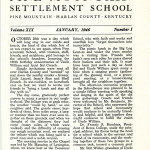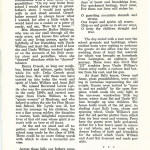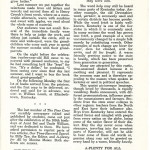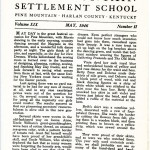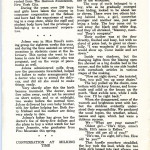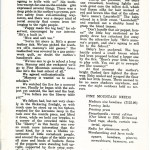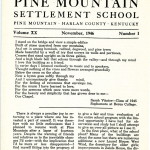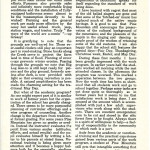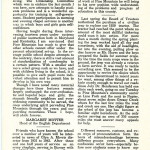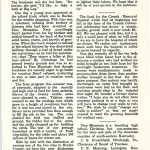Pine Mountain Settlement School
Series 17: PMSS Publications (Published by the School)
NOTES – 1946
“Notes from the Pine Mountain Settlement School”
January, May & November
GALLERY: NOTES – 1946 January
- NOTES – 1946 January, page 1. [PMSS_notes_1946_jan_001.jpg]
- NOTES – 1946 January, page 2.[PMSS_notes_1946_jan_002.jpg]
- NOTES – 1946 January, page 3. [[PMSS_notes_1946_jan_003.jpg]
- NOTES – 1946 January, page 4.[PMSS_notes_1946_jan_004.jpg]
CONTENTS
NOTES – 1946 JANUARY: 100th birthday anniversary ; Mr. Manning ; Big Log ; Lean-to ; Schoolhouse ; Mr. Benjamin ; Dr. Francis S. Hutchins ; Brit Wilder ; Mrs. Marguerite Butler Bidstrup ; Henry Creech ; Delia Creech ; Rev. Lewis Lyttle ; school song ; lyrics ; religion ; linguistics ; The Pine Cone ; picnics ; Little Laurel ; Isaac’s Run ; Shell Branch ;
The words Humanity, Truth, Honesty and Self-Control are carved on the four stone pillars supporting the Schoolhouse at Pine Mountain.
GALLERY: NOTES – 1946 May
- NOTES – 1946 May, page 1. [PMSS_notes_1946_may_001.jpg]
- NOTES – 1946 May, page 2.[PMSS_notes_1946_may_002.jpg]
- NOTES – 1946 May, page 3.[PMSS_notes_1946_may_003.jpg]
- NOTES – 1946 May, page 4.[PMSS_notes_1946_may_004.jpg]
CONTENTS
NOTES – 1946 MAY: May Day ; Morris dancing ; skirts ; clothing ; Cooperative Group ; Gladys Hill ; Harmon Foundation ; filming ; medical care ; cornshuck dolls ; financing ; food ; education ; needs ; academics ; music ; medicine ;
GALLERY: NOTES – 1946 November
- NOTES – 1946 November, page 1. [PMSS_notes_1946_nov_001.jpg]
- NOTES – 1946 November, page 2.[PMSS_notes_1946_nov_002.jpg]
- NOTES – 1946 November, page 3.[PMSS_notes_1946_nov_003.jpg]
- NOTES – 1946 November, page 4.[PMSS_notes_1946_nov_004.jpg]
CONTENTS
NOTES – 1946 NOVEMBER: Sarah Vitatoe ; poem ; Margaret Motter ; Glyn A. Morris ; Mr. [William] Hayes ; farm jeep ; Dr. Henderson ; Henry Creech ; J.S. Crutchfield ; C.N. Manning ; H.R.S. Benjamin ; linguistics ; farm program ; Creech Memorial Hospital ;
The fact that the school is accredited and is given “A” rating by the State Department of Education speaks for itself regarding the standard of work being done. – Margaret Motter

